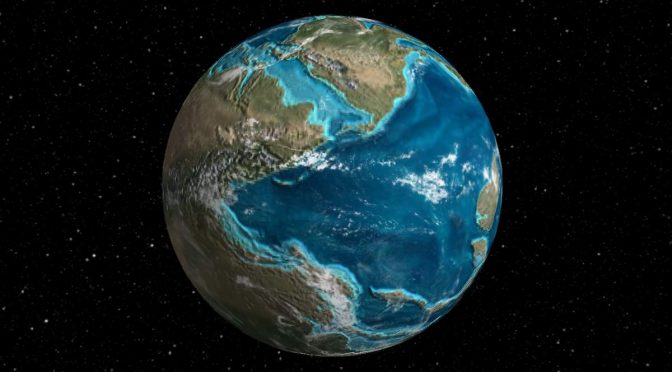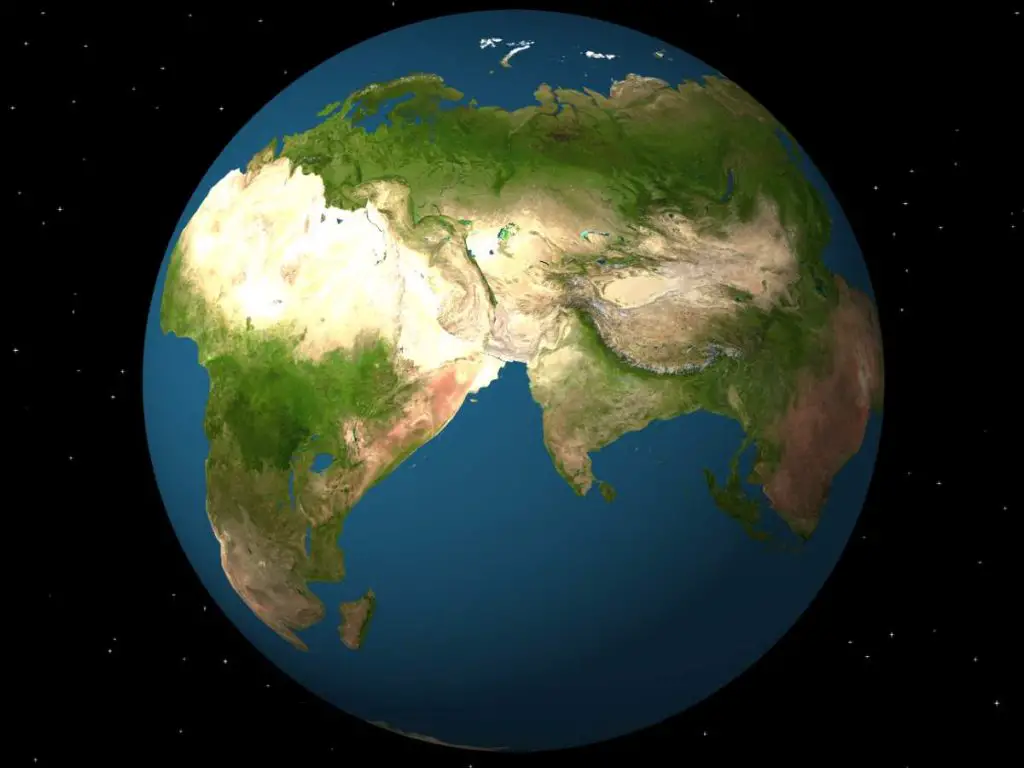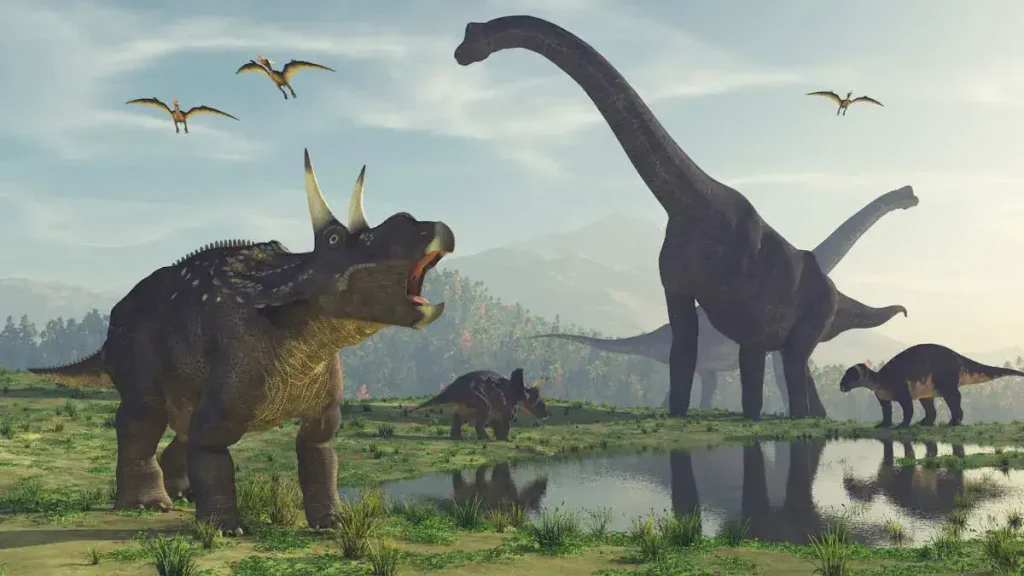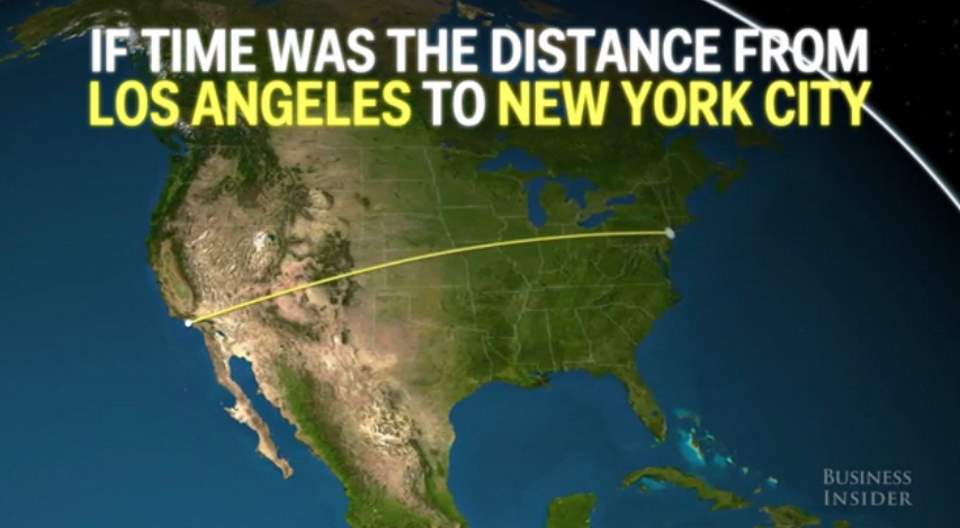I stumbled upon an amazing web page showing what did ancient Earth look like. On the “Dinosaur Pictures and Facts” web page (dinosaurpictures.org), there’s also an interactive animation. On this page, you can either select the years (i.e. 600 million years ago) or jump to a particular event (i.e. first multicellular life) and see how ancient Earth did look like then. You can also remove the clouds and stop the Earth’s rotation if you want to.
Earth’s outer shell is divided into multiple plates that slowly glide over the mantle. The movement of these plates slowly changes Earth’s surface over time by merging, or separating, continents. Plate tectonics is the scientific theory describing the large-scale motion of seven major plates and the movements of a larger number of smaller plates of the Earth’s lithosphere since tectonic processes began on Earth between 3 and 3.5 billion years ago.
Ancient Earth – A Brief History
600 million years ago
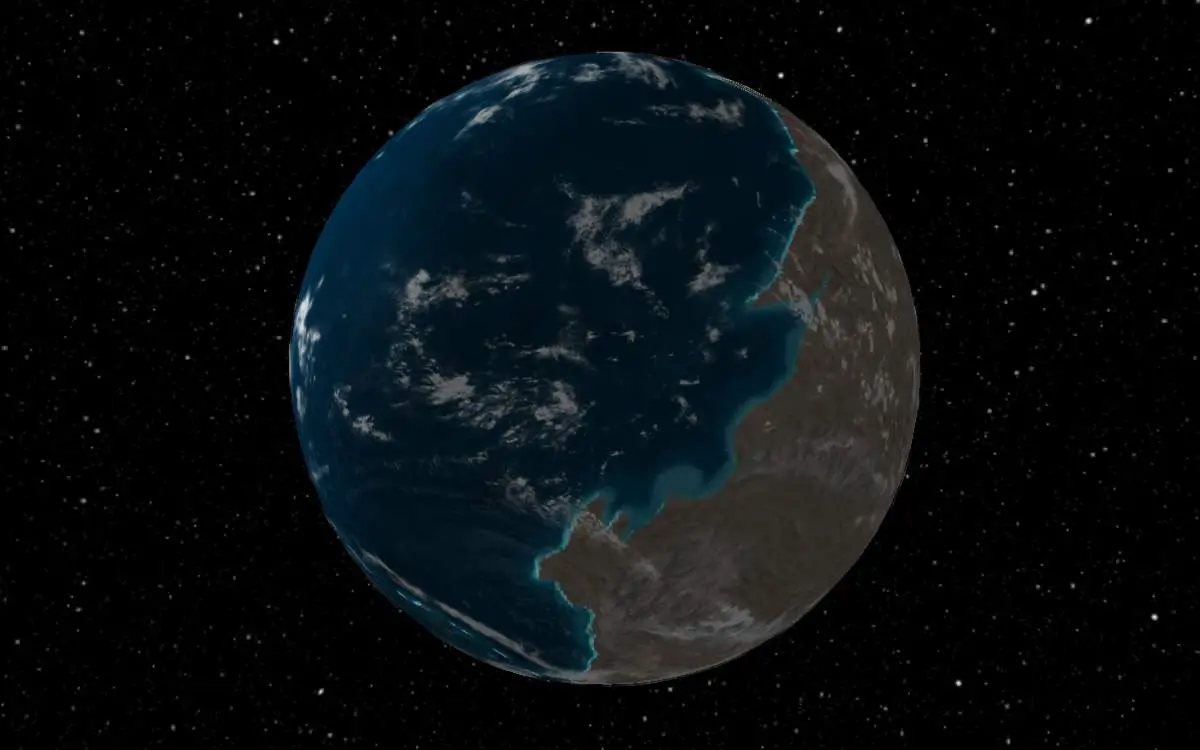
Ediacaran Period. There was a supercontinent called Pannotia (from Greek: pan-, “all”, -nótos, “south”; meaning “all southern land”), also known as the Vendian supercontinent, Greater Gondwana, and the Pan-African supercontinent. Life is evolving in the sea, and multicellular life is just beginning to emerge.
560 million years ago
Late Ediacaran. Bacteria and green algae were common in the seas, as were the enigmatic acritarchs, planktonic single-celled algae of uncertain affinity. But the Ediacaran also marks the first appearance of a group of large fossils collectively known as the “Ediacaran biota.” There is evidence that Earth’s first mass extinction happened during this period when early animals changed the environment.
540 million years ago
Early Cambrian Period. A mass extinction has just taken place (End-Ediacaran extinction in the Precambrian period, 542 Ma, see notes 1). Afterward, the fossil record shows a dramatic expansion of animal life in the sea, known as the “Cambrian explosion.”
Animals are beginning to evolve shells and exoskeletons. The Earth was generally cold during the early Cambrian, probably due to the ancient continent of Gondwana covering the South Pole and cutting off polar ocean currents. However, average temperatures were 7 degrees Celsius higher than today. There were likely polar ice caps and a series of glaciations, as the planet was still recovering from an earlier Snowball Earth. Most animal life during the Cambrian was aquatic.
500 million years ago
Late Cambrian. Most animal life during the Cambrian was aquatic. While the early Cambrian showed such diversification that it has been named the Cambrian Explosion, this changed later in the period, when there occurred a sharp drop in biodiversity. The latter half of the Cambrian was surprisingly barren and shows evidence of several rapid extinction events.
Around 515 million years ago, the balance of life on Earth shifted dramatically, with extinctions surpassing the appearance of new species. This marked a critical moment in the history of biodiversity. Over the next five million years, the number of biological genera declined sharply, dropping from a peak of approximately 600 to just 450. At the same time, the rate of new species formation, or speciation, fell significantly across many groups, plummeting to just 20-30% of earlier levels. These disruptions underscore a period of ecological upheaval.
By 500 million years ago, the situation worsened as Earth’s oceans underwent a severe crisis. Oxygen levels in the seas dropped dramatically, creating widespread hypoxia—a condition of low oxygen that suffocates marine life. Simultaneously, levels of hydrogen sulfide, a toxic gas lethal to most organisms, surged in the water. This combination of deoxygenation and poisoning triggered yet another wave of extinctions, reshaping life in Earth’s primordial oceans.
470 million years ago
Ordovician period (named after the Celtic tribe of the Ordovices). During this period, the area north of the tropics was almost entirely ocean, and most of the world’s land was collected into the southern supercontinent Gondwana. Throughout the Ordovician, Gondwana shifted towards the South Pole and much of it was submerged underwater.
At the beginning of the period, around 485.4 million years ago, the climate was very hot due to a high concentration of CO2 (4200 ppm) in the atmosphere, which gave a strong greenhouse effect. By contrast, today the concentration is just above 400 ppm. Marine water temperatures are assumed to have averaged 45 °C (113 °F), which restricted the diversification of complex multi-cellular organisms. But over time, the climate became cooler, and around 460 million years ago, the ocean temperatures became comparable to those of present-day equatorial waters.
450 million years ago
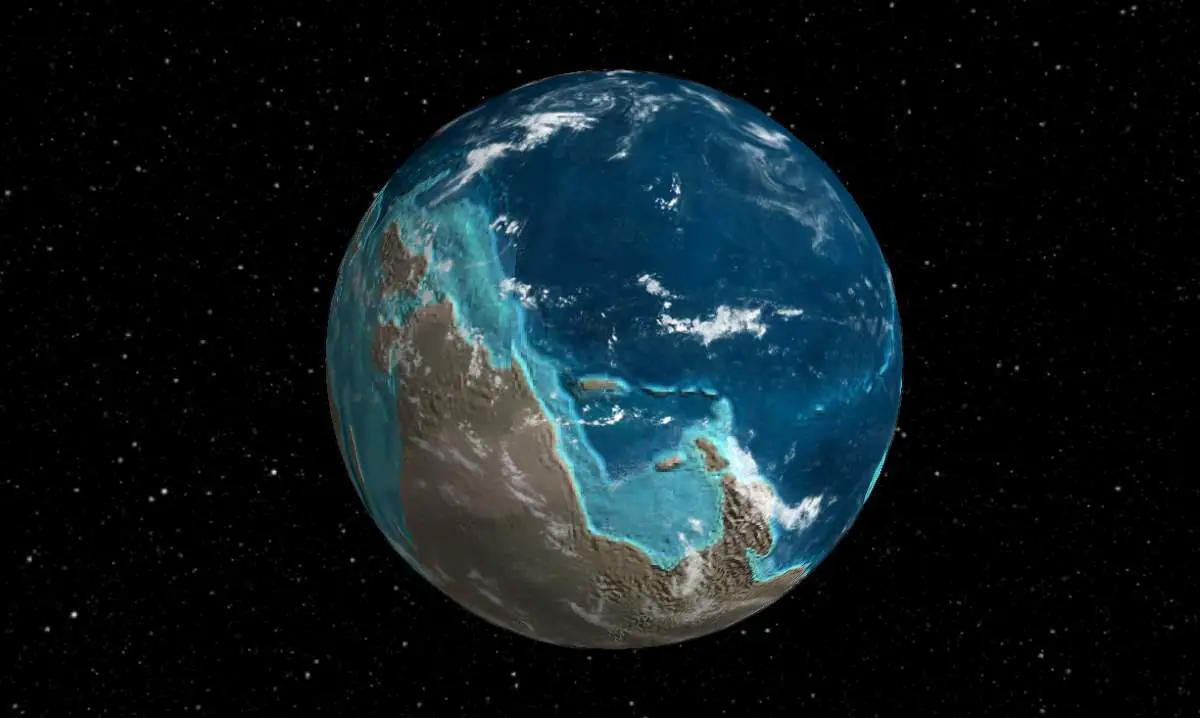
Late Ordovician. Life continued to flourish during the Ordovician as it did in the earlier Cambrian period, although the end of the period was marked by the Ordovician-Silurian extinction event. The seas are diverse and the first coral reefs have emerged. Algae is the only multicellular plant, and there is still no complex life on land. Invertebrates, namely molluscs and arthropods, dominated the oceans. The Great Ordovician Biodiversification Event considerably increased the diversity of life. Fish, the world’s first true vertebrates, continued to evolve, and those with jaws may have first appeared late in the period. Life had yet to diversify on land. About 100 times as many meteorites struck the Earth per year during the Ordovician compared with today.
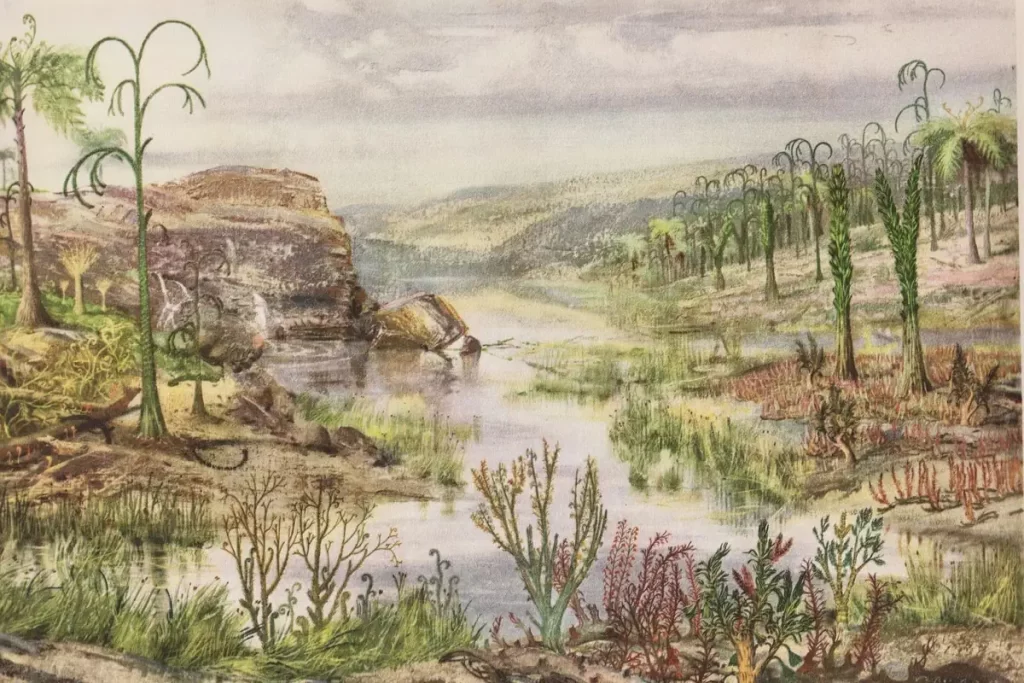
Related: The Timeline of Earth
As the Ordovician progressed, we see evidence of glaciers on the land we now know as Africa and South America, which were near the South Pole at the time, and covered by ice caps.
430 million years ago
Silurian period. Ordovician-Silurian extinction event recently took place and wiped out 60%-70% of all species. A significant evolutionary milestone during the Silurian was the diversification of jawed and bony fish. Multi-cellular life also began to appear on land in the form of small, bryophyte-like, and vascular plants that grew beside lakes, streams, and coastlines, and terrestrial arthropods are also first found on land during the Silurian. However, terrestrial life would not greatly diversify and affect the landscape until the Devonian.
Perhaps most striking of all biological events in the Silurian was the evolution of vascular plants – which have the ability to transport water and nutrients through their tissues.
During this period, the Earth entered a long, warm greenhouse phase, supported by high CO2 levels of 4500 ppm, and warm shallow seas covered much of the equatorial landmasses. Early in the Silurian, glaciers retreated back into the South Pole until they almost disappeared in the middle of Silurian.
400 million years ago
Devonian period. It is named after Devon, also known as Devonshire, a county of England. The oldest rocks found in that area are approximately 395-345 million years old, and they were first studied from this period – hence the name. It is sometimes called the “Age of Fish” because of the diverse, abundant, and, in some cases, bizarre types of these creatures that swam Devonian seas.
Life was also well underway in its colonization of the land – where the first vertebrates walk on. The Devonian period marks the beginning of extensive land colonization by plants. With large land-dwelling herbivores not yet present, large forests grew and shaped the landscape.
The Devonian was a relatively warm period and probably lacked any glaciers. The temperature gradient from the equator to the poles was not as large as it is today. The weather was also very arid, especially along the equator.
The Devonian period was a time of great tectonic activity, as Euramerica and Gondwana drew closer together.
The continent Euramerica (or Laurussia) was created in the early Devonian by the collision of Laurentia and Baltica, which rotated into the natural dry zone along the Tropic of Capricorn, which is formed as much in Paleozoic times as nowadays by the convergence of two great air-masses, the Hadley cell, and the Ferrel cell. In these near-deserts, the Old Red Sandstone sedimentary beds formed, made red by the oxidized iron (hematite) characteristic of drought conditions.
Near the equator, the plate of Euramerica and Gondwana were starting to meet, beginning the early stages of the assembling of Pangaea. This activity further raised the northern Appalachian Mountains and formed the Caledonian Mountains in Great Britain and Scandinavia.
The west coast of Devonian North America, by contrast, was a passive margin with deep silty embayments, river deltas, and estuaries, found today in Idaho and Nevada; an approaching volcanic island arc reached the steep slope of the continental shelf in Late Devonian times and began to uplift deepwater deposits, a collision that was the prelude to the mountain-building episode at the beginning of the Carboniferous called the Antler orogeny.
Sea levels were high worldwide, and much of the land lay under shallow seas, where tropical reef organisms lived. The deep, enormous Panthalassa (the “universal ocean”) covered the rest of the planet. Other minor oceans were the Paleo-Tethys Ocean, Proto-Tethys Ocean, Rheic Ocean, and Ural Ocean (which was closed during the collision with Siberia and Baltica).
370 million years ago
Late Devonian. Life on land becomes more complex as plants develop. Insects diversify and fish develop sturdy fins, which eventually evolve into limbs.
The second-largest extinction in Earth’s history (Late Devonian extinction) occurred in this period. At least 70% of all species were gone.
A range of evidence, such as plant distribution, points to a Late Devonian warming.

340 million years ago
Carboniferous period. Plants are developing root systems that allow them to grow larger and move inland. Environments are evolving below tree canopies. Atmospheric oxygen increases as plants spread on land. Early reptiles are evolving.
The Carboniferous Period is famous for its vast swamp forests. Such swamps produced the coal from which the term Carboniferous, or “carbon-bearing,” is derived.
300 million years ago
Late Carboniferous. Coal beds, which can be up to 11 to 12 meters thick, characterize the late Carboniferous. Early reptiles have evolved, and giant insects have diversified. The Late Carboniferous collision of Laurasia (present-day Europe, Asia, and North America) into Gondwana (present-day Africa, South America, Antarctica, Australia, and India) produced the Appalachian mountain belt of eastern North America and the Hercynian Mountains in the United Kingdom. A further collision of Siberia and Eastern Europe created the Ural Mountains of Russia.
280 million years ago
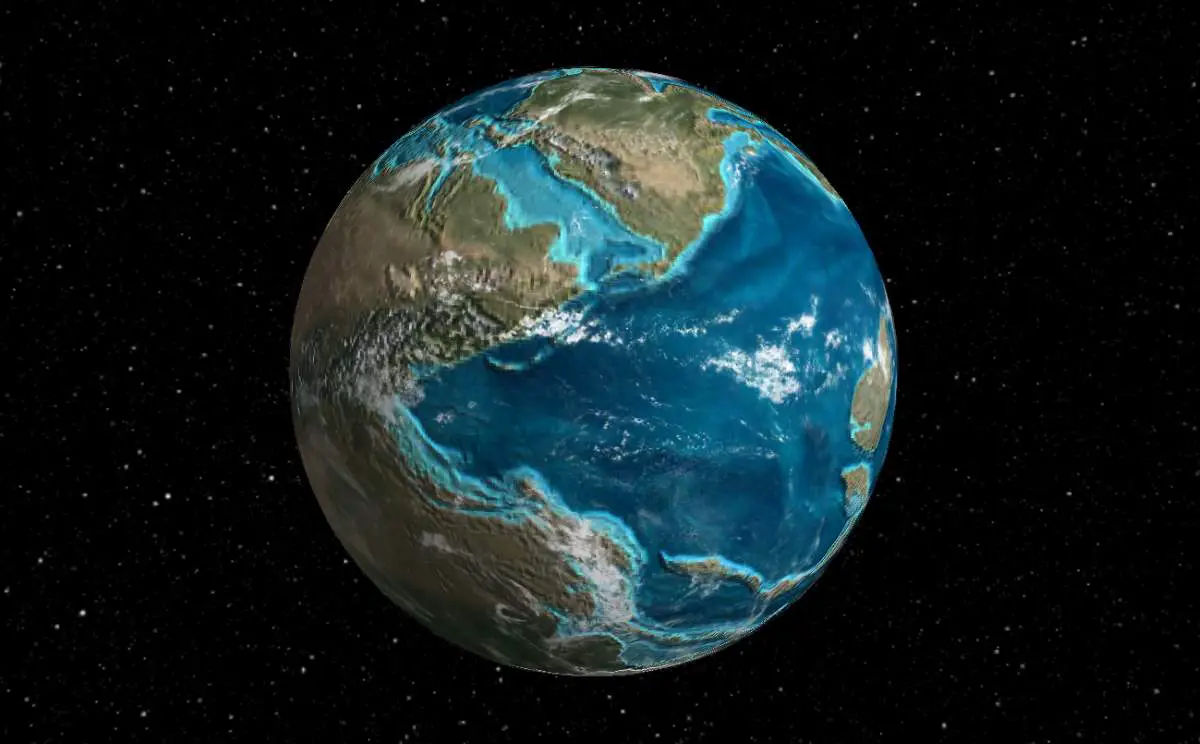
Permian period. The concept of the Permian was introduced in 1841 by geologist Sir Roderick Murchison, who named it after the Russian city of Perm.
The Permian witnessed the diversification of the early amniotes into the ancestral groups of mammals, turtles, lepidosaurs, and archosaurs. The world at the time was dominated by two continents known as Pangaea and Siberia, surrounded by a global ocean called Panthalassa. The Carboniferous rainforest collapse left behind vast regions of desert within the continental interior. Amniotes, who could better cope with these drier conditions, rose to dominance in place of their amphibian ancestors.
Extreme conditions such as polar ice caps and deserts limited the extent of plant life, but amphibious tetrapods and reptiles diversified where plants grew. Oceans teemed with fish and invertebrate life.
260 million years ago
Late Permian. The greatest mass extinction in Earth’s history, the Permian-Triassic extinction event, colloquially known as the Great Dying, is about to take place, driving 90% of species extinct. The extinction of plants reduced the food supply for large herbivorous reptiles and removed habitat for insects.
240 million years ago
Early Triassic. Both the start and end of the period are marked by major extinction events. During the Early Triassic, oxygen levels were significantly lower due to the extinction of many land plants. Many corals went extinct, and new modern types of corals appeared, forming small patches of reefs of modest extent compared to the great reef systems of Devonian or modern times. Small ancestors to birds, mammals, and dinosaurs survive.

The Triassic continental interior climate was generally hot and dry, so typical deposits are red bed sandstones and evaporites. There is no evidence of glaciation at or near either pole; in fact, the polar regions were apparently moist and temperate, providing a climate suitable for forests and vertebrates, including reptiles. Pangaea’s large size limited the moderating effect of the global ocean; its continental climate was highly seasonal, with very hot summers and cold winters. The strong contrast between the Pangaea supercontinent and the global ocean triggered intense cross-equatorial monsoons.
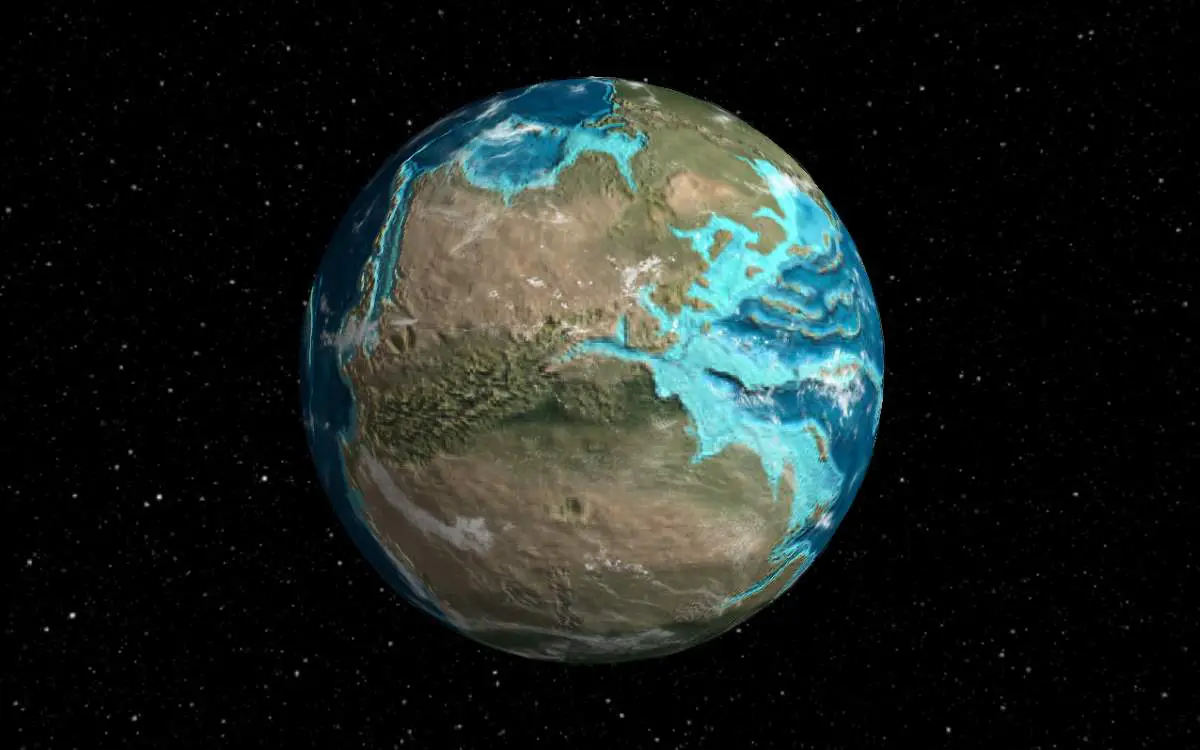
220 million years ago
Middle Triassic. The Triassic began in the wake of the Permian-Triassic extinction event, which left the Earth’s biosphere impoverished; it would take well into the middle of this period for life to recover its former diversity. Small dinosaurs begin to appear. Therapsids and archosaurs emerge, along with the first flying invertebrates. There were no flowering plants, but instead, there were ferns and mosses.
200 million years ago
Late Triassic. The Triassic-Jurassic extinction event is about to happen, resulting in the disappearance of 70%-75% of all terrestrial and marine life species and greatly reducing surviving populations. Some families, such as pterosaurs, crocodiles, mammals, and fish were minimally affected. The first true dinosaurs emerge, but they did not become dominant until the succeeding Jurassic Period. The end of the Triassic also brought about the decline of corals and reef builders during what is called a “reef gap”.
The supercontinent Pangaea was rifting during the Late Triassic but had not yet separated.
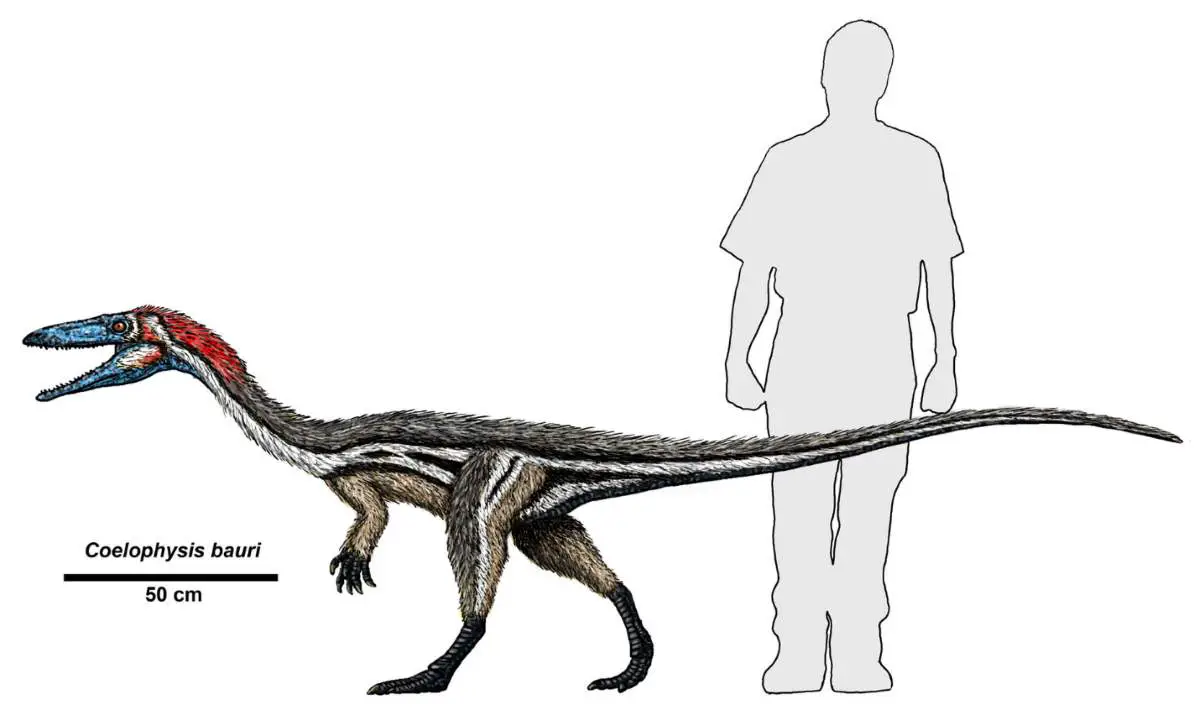
170 million years ago
Jurassic Period. It was characterized by a warm, wet climate that gave rise to lush vegetation and abundant life. Dinosaurs thrived as the first mammals (mostly very small herbivores or insectivores) and birds evolved. Ocean life was diversified.
The start of the period was marked by the major Triassic-Jurassic extinction event and the acceleration of the breakup of the supercontinent Pangaea. It began rifting into two landmasses: Laurasia to the north, and Gondwana to the south. This created more coastlines as the new oceans flooded the spaces in between, and shifted the continental climate from dry to humid, and many of the arid deserts of the Triassic were replaced by lush rainforests.
During the Jurassic period, the primary vertebrates living in the sea were fish and marine reptiles. On land, various archosaurian reptiles remained dominant. The Jurassic was a golden age for the large herbivorous dinosaurs known as the sauropods.
The Jurassic is named after the Jura Mountains within the European Alps, where limestone strata from the period were first identified.
150 million years ago
Late Jurassic. The earliest lizards have appeared and primitive placental mammals have evolved. Dinosaurs dominate both landmasses. Sauropods had become widespread. They are notable for the enormous sizes attained by some species, and the group includes the largest animals to have ever lived on land. Large marine reptiles inhabited the ocean, and pterosaurs were the dominant flying vertebrates. They ruled the skies, filling many ecological roles now taken by birds, and may have already produced some of the largest flying animals of all time.
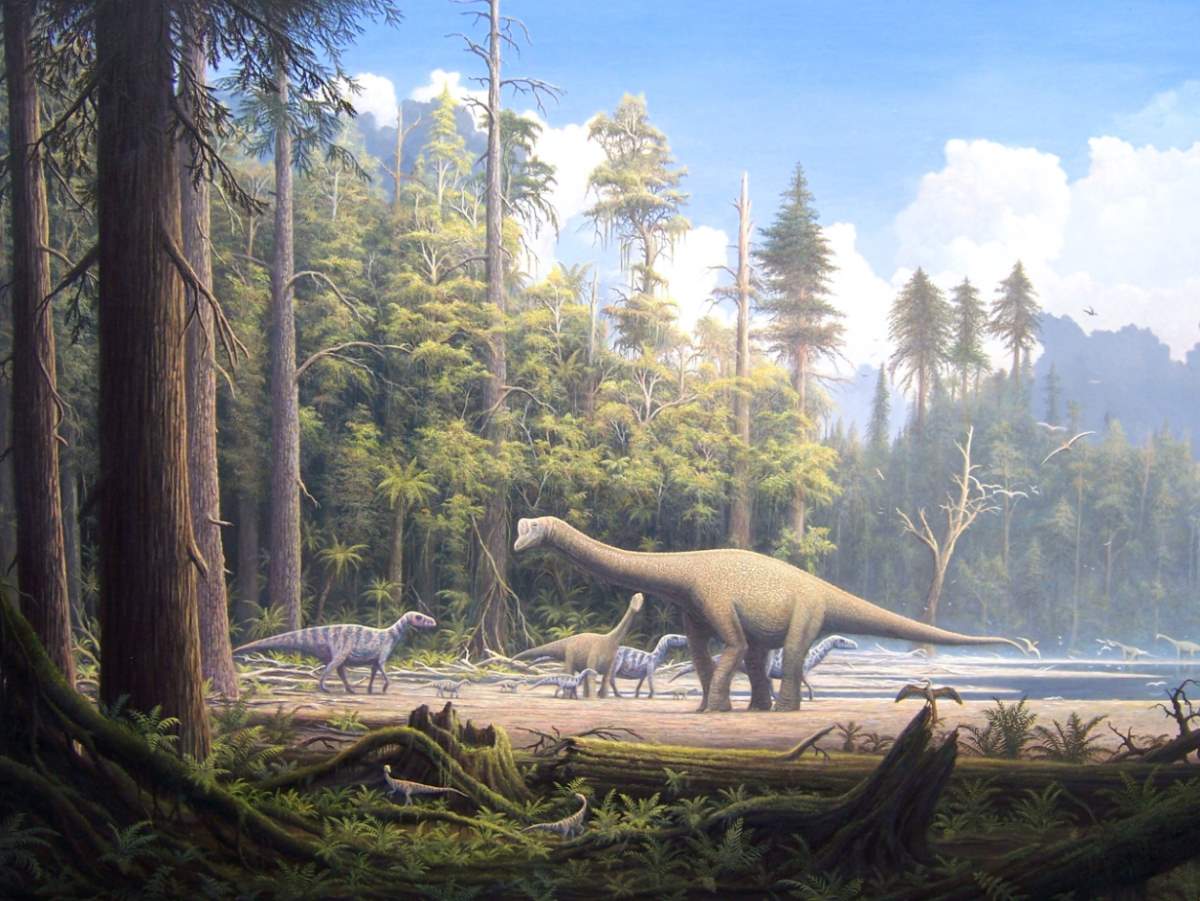
120 million years ago
Early Cretaceous. Despite the cooling trend of the last epoch of the Jurassic continued into the early Cretaceous, the world is warm and has no polar ice caps. Glaciation was however restricted to high-latitude mountains. Large reptiles dominate and mammals remain small. Flowering plants evolve and spread throughout the world.
105 million years ago
Early Cretaceous. Ceratopsian and pachycephalosaurid dinosaurs evolve. Modern mammal, bird, and insect groups emerge.
66 million years ago
Late Cretaceous. The Chicxulub impactor, an asteroid or comet at least 10 kilometers (6 miles) in diameter impacted a few miles from the present-day town of Chicxulub in Mexico, at around 64,000 kilometers per hour (40,000 mph). The impact has created a crater (Chicxulub crater) more than 180 km (110 miles) in diameter, making it the third-largest known impact crater on Earth. The impact caused the Cretaceous-Paleogene extinction event, and 75% of all species, including dinosaurs (except avian dinosaurs), many marine reptiles, all flying reptiles, and many marine invertebrates became extinct. Some animals, including many small mammals, managed to survive.
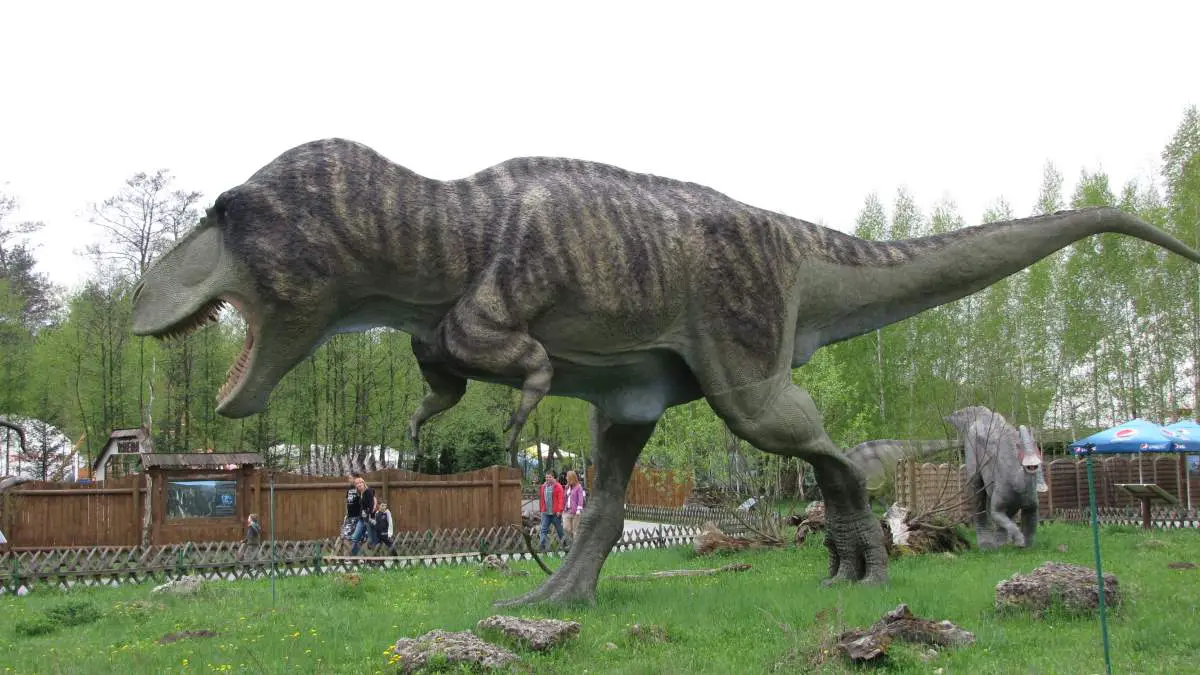
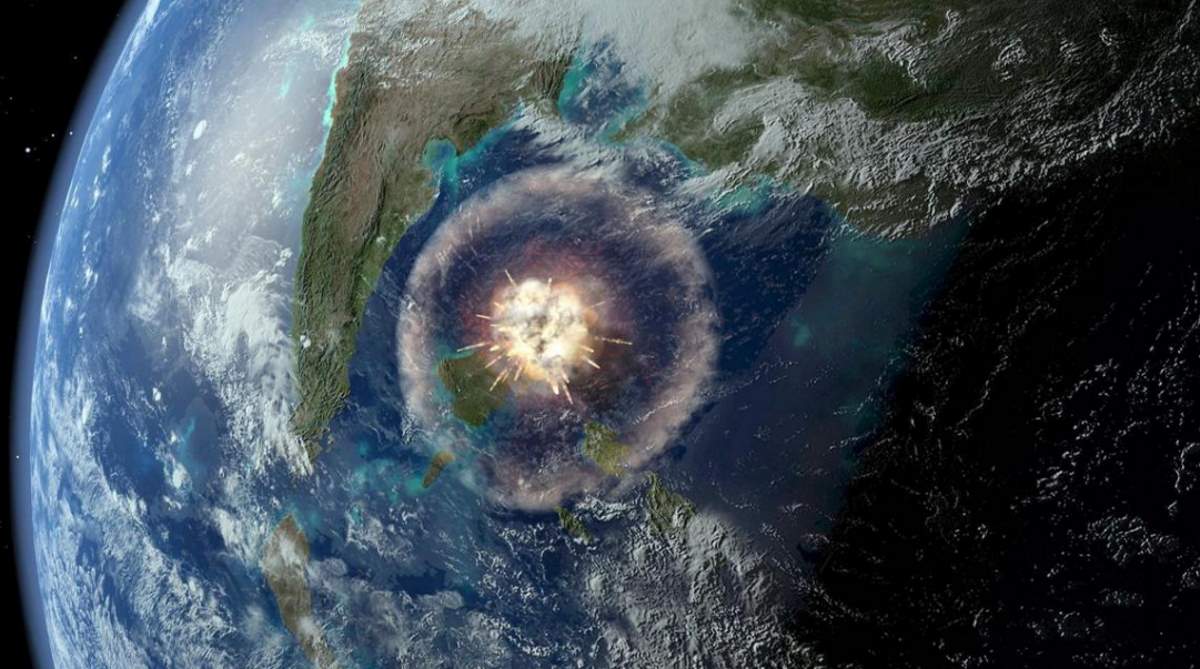
50-23 million years ago
Paleogene period. The Paleogene is informally known as the Lower Tertiary or Early Tertiary. The Tertiary is no longer recognized as a formal unit by the International Commission on Stratigraphy (see notes 2), but the word is still widely used.
After the Cretaceous-Paleogene extinction event, mammals began a rapid diversification and transformed from a few small and generalized forms that began to evolve into most of the modern varieties we see today. Some of these mammals would evolve into large forms that would dominate the land, while others would become capable of living in marine, specialized terrestrial, and airborne environments.
Those that took to the oceans became modern cetaceans (whales, dolphins, and porpoises), while those that took to the trees became primates, the group to which humans belong. Birds, or avian dinosaurs, which were already well established by the end of the Cretaceous, also experienced adaptive radiation as they took over the skies left empty by the now extinct Pterosaurs. In comparison to birds and mammals, most other branches of life remained relatively unchanged during this period.

Related: Largest Prehistoric Mammals
23.03-2.58 million years ago
Neogene period. Mammals and birds continued to evolve into roughly modern forms, while other groups of life remained relatively unchanged. Early hominids, the ancestors of humans, appeared in Africa near the end of the period.
Some continental movement took place, the most significant event being the connection of North and South America at the Isthmus of Panama, late in the Pliocene. This cut off the warm ocean currents from the Pacific to the Atlantic Ocean, leaving only the Gulf Stream to transfer heat to the Arctic Ocean.
The global climate cooled considerably over the course of the Neogene, culminating in a series of continental glaciations in the Quaternary Period that followed.
0. Earth Today
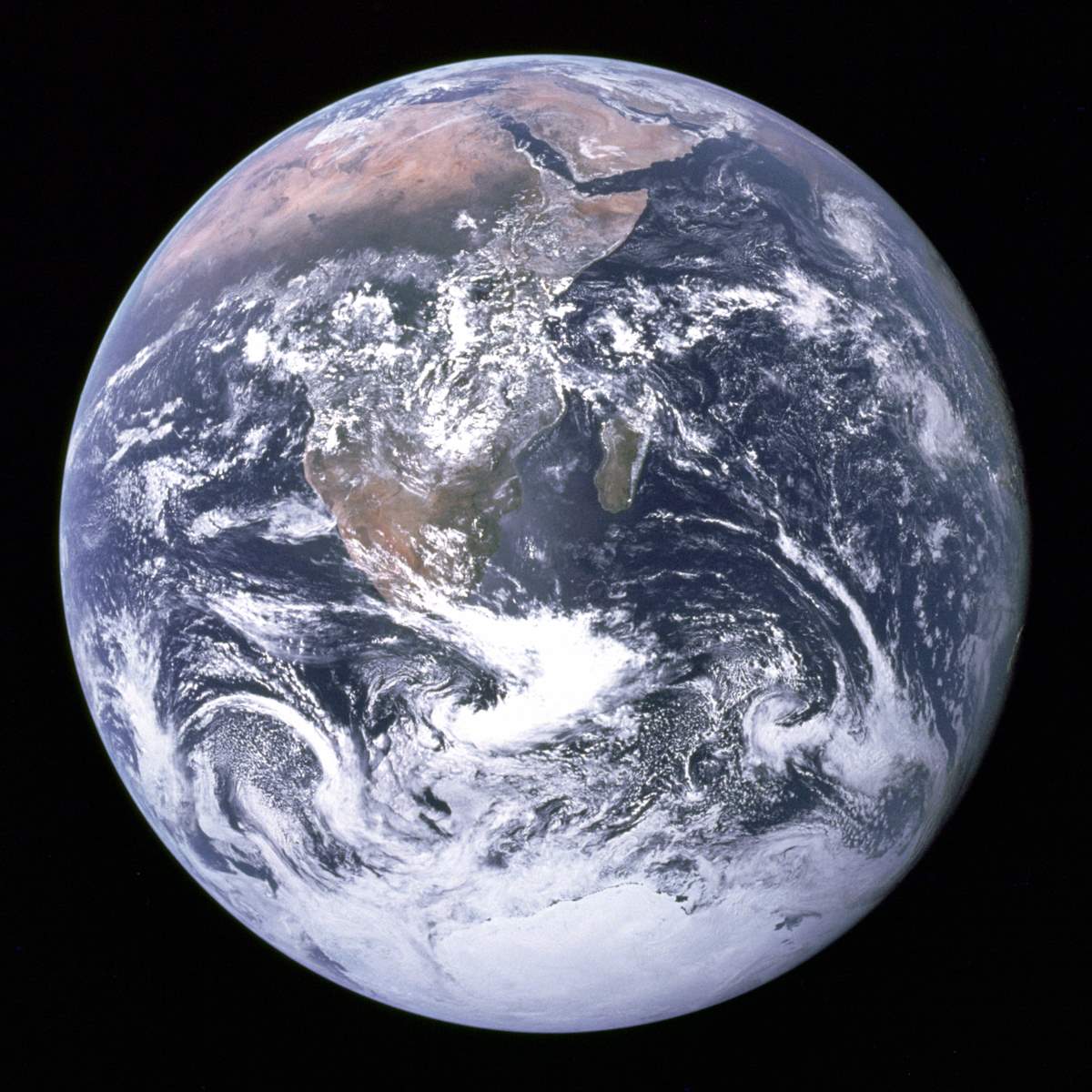
So, in today’s terms, image AS17-148-22727 went “viral” and became a symbol of the environmental movement, as a depiction of Earth’s frailty, vulnerability, and isolation amid the vast expanse of space. According to NASA archivist Mike Gentry, it is among the most widely distributed images in human history.
Notes
- Traditionally, geologists have used different abbreviations for ages (time before present) and duration (amount of time elapsing between two different events). Ages are abbreviated from Latin: Ga (giga-annum) is a billion years, Ma (mega-annum) is a million years, ka (kilo-annum) is a thousand years.
- See “Whatever happened to the Tertiary and Quaternary?” on the GeoWhen Database.
Sources
- What did ancient Earth look like? on dinosaurpictures.com
Pannotia on Wikipedia- The Ediacaran Period on the University of Berkeley website
- Ediacaran on Wikipedia
- Cambrian on Wikipedia
- Cambrian explosion on Wikipedia
- Ordovician on Wikipedia
- “The Ordovician Period” on the California Museum and Paleontology website
- Silurian on Wikipedia
- Devonian on Wikipedia
- Devon on Wikipedia
- The Carboniferous Period on the California Museum and Paleontology website
- Permian on Wikipedia
- Triassic on Wikipedia
- Jurassic on Wikipedia
- Cretaceous on Wikipedia
- Paleogene on Wikipedia
- Tertiary on Wikipedia
- “Whatever happened to the Tertiary and Quaternary?” on GeoWhen Database
- Neogene on Wikipedia
- How Many Elephants are Left in the World in 2025? - August 17, 2025
- Moon Landings: All-Time List [1966-2025] - February 2, 2025
- What Is Max-Q and Why Is It Important During Rocket Launches? - January 16, 2025
